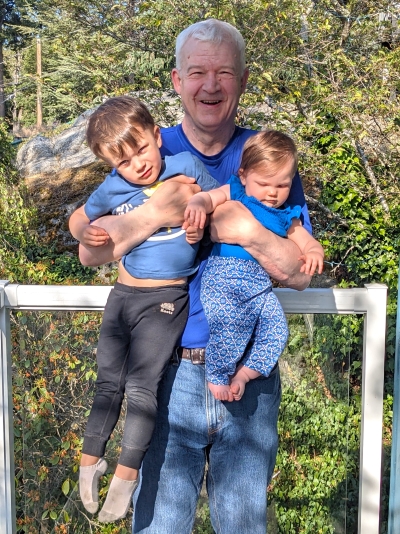 On February 7, 2025, Doug Wrean became the ninth patient to undergo robotic-assisted surgery at Royal Jubilee Hospital—a milestone in the hospital’s new era of surgical innovation. Under the skilled hands of Dr. Michael Metcalfe, and with Dr. Iain McAuley at the bedside, the urologists performed a robotic prostatectomy (removal of the prostate), marking not just a personal turning point in Doug’s health, but also a remarkable advancement in local prostate cancer care.
On February 7, 2025, Doug Wrean became the ninth patient to undergo robotic-assisted surgery at Royal Jubilee Hospital—a milestone in the hospital’s new era of surgical innovation. Under the skilled hands of Dr. Michael Metcalfe, and with Dr. Iain McAuley at the bedside, the urologists performed a robotic prostatectomy (removal of the prostate), marking not just a personal turning point in Doug’s health, but also a remarkable advancement in local prostate cancer care.
Four months later, over 100 patients have benefitted from this leading-edge technology, many of whom were able to return home within 24 hours and resume their regular routines just weeks later. The results have been overwhelmingly positive: faster recoveries, fewer complications, and renewed hope for patients across Vancouver Island.
Doug generously shares his experience with Foundation donors:
“My wife and I have been proud supporters of the Victoria Hospitals Foundation since Alanna was successfully treated for breast cancer sixteen years ago. We’ve followed the bold journey it’s been on, contributed to campaigns along the way, and taken pride in contributing to better patient care in Victoria—especially through the introduction of surgical robotics at Royal Jubilee Hospital. But never did we imagine that I would become one of the first patients to benefit from this technology, a profound and personal gift that repaid our contributions to the Foundation a thousandfold.
I was 66 when blood tests revealed a sustained spike in my PSA (Prostate-Specific Antigen) level. I have always been diligent about my health, so I was pleased to have my proactive family doctor, Dr. Tim McKay, refer me to Dr. Metcalfe. I had two biopsies, including an MRI-guided fusion biopsy, which confirmed that I had prostate cancer.
Even if you see it coming, a report with your name on it and the term “adenocarcinoma,” it hits hard. What was critically helpful in this moment was being able to immediately discuss treatment options, calmly and clearly, with a urologist as confident and reassuring as Dr. Metcalfe. He’s trained at top Canadian universities and at MD Anderson in Texas—one of the top cancer centres in the world. Having urologists of this calibre here in Victoria speaks volumes about the level of care we’re fortunate to have.
The options were laid out for me: surgery, or radiation combined with hormone therapy. But after learning I had the option to have robotic assisted surgery, it gave me even greater confidence to proceed with the surgical route. Alanna and I had read about the Foundation’s efforts to bring a robotics program to the Island and knew that the precision of robotic-assisted surgery minimizes impacts on patients during and after surgery. Knowing I would only be in the hospital a short time, was critical to me opting for this approach, which I did after speaking to a nurse-navigator at the Island Prostate Centre, and numerous friends who had already dealt with this far-too-common form of cancer.
Talking to your children about cancer, even if they are grown, isn’t easy. Our two children were now learning that their other parent needed cancer treatment. Being told that a parent was in the hands of an excellent team, lead by a highly qualified surgeon using the best available technology, made the message much easier to accept.
My surgery took place on February 7, just three months after diagnosis, and three months after the Foundation’s surgical campaign had launched.
I was out of the hospital within 28 hours whereas patients used to spend up to five days in the hospital for this form of prostate surgery. The technology truly makes an incredible difference—not just for patients like me, but for the entire healthcare system by minimizing the length of hospital stays and need for nursing care.
I felt so well post-op, I probably could have gone home that day. But as one of the first patients in the robotic-assisted surgery program, I stayed longer so the team could ensure every protocol was followed to the letter. I knew I was in the best hands, surrounded by a healthcare team that anticipated and cared for my every need.
The procedure itself left me with five small keyhole incisions—each less than an inch, and one incision, about two inches. I had no fever, pain, or other immediate side effects, and within a couple of weeks I was back riding a bike and doing everything else I love. Honestly, the biggest adjustment was being told not to pick up my grandkids, now aged four and one, for a month.

I’m now part of a survivors’ group, organized through the Island Prostate Centre, which I walk with every Tuesday. Through these connections, I’ve met other men who faced the same diagnosis but underwent radiation or traditional open prostate surgery, and whose recovery was often significantly longer or more difficult than mine. Thanks to robotic-assisted surgery, I experienced a level of precision and care that dramatically shortened my recovery and let me return to my normal routine, the highlight of which is spending time with my grandchildren.
Before the surgery, I asked Dr. Metcalfe if my recovery might interfere with my daughter’s wedding in August, bracing myself for a possible problem. Without hesitation, he said, “Absolutely not.” That kind of peace of mind is truly priceless.
Having spent my career in the BC public service—including several years as a health analyst with Treasury Board Staff (Ministry of Finance) —I know the challenges our healthcare system faces, but I can say without hesitation that the people and the care at Royal Jubilee are exceptional.
I’m deeply thankful to every nurse, technician, administrator, and physician who supported me—not just for their expertise, but for their compassion, their steadiness, and the kindness they showed me at every step.
It was an A+ experience for me and I’d go the robotic surgical route again, if I had to, in a heartbeat.
My wife was so moved by the care I received that she felt compelled to write to the Times Colonist, wanting the entire community to know just how extraordinary our entire hospital teams are.
I’m also thankful to Foundation donors—their support and generosity make it possible for patients like me to benefit from the best-available technology. More than ever, I am proud to be part of this donor family. My story is proof of what we can accomplish, and the impact we can make together, as a community.




